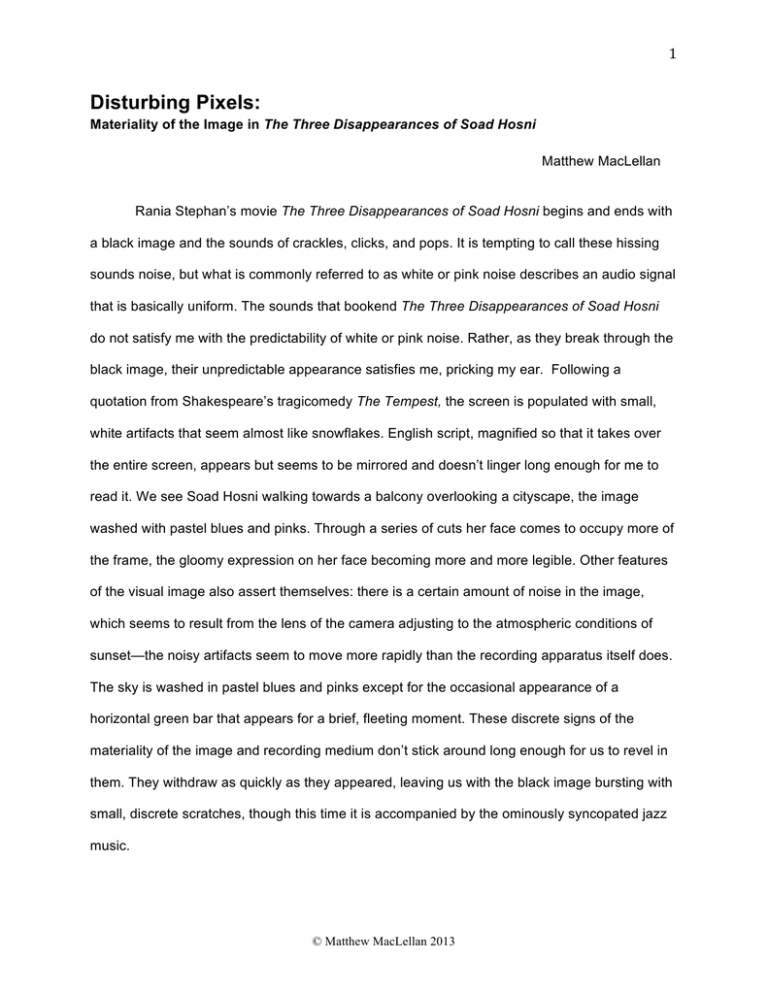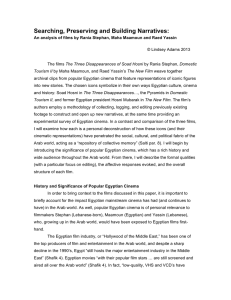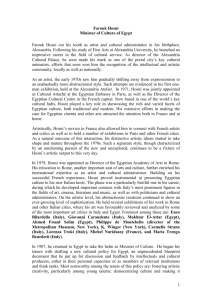Document 10574729
advertisement

1 Disturbing Pixels: Materiality of the Image in The Three Disappearances of Soad Hosni Matthew MacLellan Rania Stephan’s movie The Three Disappearances of Soad Hosni begins and ends with a black image and the sounds of crackles, clicks, and pops. It is tempting to call these hissing sounds noise, but what is commonly referred to as white or pink noise describes an audio signal that is basically uniform. The sounds that bookend The Three Disappearances of Soad Hosni do not satisfy me with the predictability of white or pink noise. Rather, as they break through the black image, their unpredictable appearance satisfies me, pricking my ear. Following a quotation from Shakespeare’s tragicomedy The Tempest, the screen is populated with small, white artifacts that seem almost like snowflakes. English script, magnified so that it takes over the entire screen, appears but seems to be mirrored and doesn’t linger long enough for me to read it. We see Soad Hosni walking towards a balcony overlooking a cityscape, the image washed with pastel blues and pinks. Through a series of cuts her face comes to occupy more of the frame, the gloomy expression on her face becoming more and more legible. Other features of the visual image also assert themselves: there is a certain amount of noise in the image, which seems to result from the lens of the camera adjusting to the atmospheric conditions of sunset—the noisy artifacts seem to move more rapidly than the recording apparatus itself does. The sky is washed in pastel blues and pinks except for the occasional appearance of a horizontal green bar that appears for a brief, fleeting moment. These discrete signs of the materiality of the image and recording medium don’t stick around long enough for us to revel in them. They withdraw as quickly as they appeared, leaving us with the black image bursting with small, discrete scratches, though this time it is accompanied by the ominously syncopated jazz music. © Matthew MacLellan 2013 2 Watching The Three Disappearances of Soad Hosni, these signs of the underlying materiality and support of the image arrest me, acting as a co-presence beside the image of Soad Hosni. Through her process of composition, Stephan frees these analog and digital artifacts from being a barrier to seeing a clear image. Instead, she liberates these pixels and blotchy colors to have a life of their own and perhaps even their own experiences. I begin my essay by investigating the bodily existence of these glitches that appear on the image. The Three Disappearances of Soad Hosni is a seventy-minute long film directed and edited by Rania Stephan. The movie is made entirely from the VHS tapes of movies Soad Hosni starred in. Hosni starred in sixty-seven movies, and Stephan edited her movie using a large sample of these movies.1 A select number of the movies Soad Hosni acted in are available on DVD, but most people experienced Soad Hosni’s movies either in the movie theatres or, increasingly since the 1970s, in home viewing formats either on public television or on videocassette.2 Rania Stephan first encountered Soad Hosni’s movies in VHS format: in an interview, Stephan revealed that she first viewed a Soad Hosni film at her aunt’s house and later bought the VHS tapes she used to make The Three Disappearances of Soad Hosni at a VHS store in downtown Cairo.3 I follow Vivian Sobchack in finding a film to be an expression of a world. In her study The Address of the Eye: A Phenomenology of Film Experience, Sobchack argues that a film is an expression of experience by experience.4 The film itself, she argues, engages in the physical 1 IMDB credits Soad Hosni as appearing in 67 films as an actress; I counted 60 films in the end credits for Rania Stephan’s movie. In an interview, Stephan says she uses 76 films of Hosni’s out of a body of work containing 82 films. Rania Stephan, Interview with Uday Bhatia, A Fan Apart, http://fanapart.blogspot.ca/2013/08/the-threedisappearances-of-soad-hosni.html (accessed January 28, 2014). 2 For example, Al-Karnak (1975), one of the films Stephan uses in The Three Disappearances of Soad Hosni is distributed by Rotana Distribution in a relatively high-resolution DVD copy although the leading bar at the top and bottom of the image lead me to speculate it was transferred from a VHS tape. Information about public television and VHS distribution comes from Viola Shafik, “Egyptian Cinema,” in Companion Encyclopedia of Middle Eastern & North African Film, edited by Oliver Leaman (London: Routledge, 2001), 30. 3 Rania Stephan, Interview with Uday Bhatia, A Fan Apart, http://fanapart.blogspot.ca/2013/08/the-threedisappearances-of-soad-hosni.html (accessed January 28, 2014). 4 Vivian Sobchack, The Address of the Eye: A Phenomenology of Film Experience (Princeton: Princeton University Press, 1992). © Matthew MacLellan 2013 3 and material acts of seeing and hearing. Our perception of the world is selective; we tend to only perceive what interests us. Considering the camera and other recording technologies that are used to make a film such as microphones, these technologies are also selective; they give us glimpse into a world, but there is much they leave out.5 Although the film’s embodied activity in the world is transmitted to us and signifies in a primordial way, our experience of it is mediated by the perception of the camera. Rania Stephan’s The Three Disappearances of Soad Hosni inserts another layer of mediation, since the images we receive are what made it onto the VHS tapes Stephan used to make the film. We see both the way Soad Hosni moved in a profilmic world we share with her and some of the ways her images were transmitted to audiences at home in Egypt, Lebanon, and other Arabic speaking countries. How do these entities come into the body of Stephan’s movie? As previously mentioned, her movie is made entirely from videocassette tapes of Soad Hosni’s movies. To understand how these images came to be "loved to death," to borrow a phrase from Laura U. Marks, I turn to some historical information about VCR and VHS distribution in Egypt.6 This is important to consider because the more we watch a VHS, the more the tape is demagnetized, introducing new artifacts into the image. These are what we see in The Three Disappearances of Soad Hosni. As far as I can ascertain, Stephan is not willfully glitching the image. Rather, she is accepting the formal and material qualities that arise from her transferring of the images from the VHS format to a digital file. However, some compression of the image has necessarily taken place before it came into Stephan’s hands because at some point in their life, the movies were transferred from their existence on 35mm film to the more consumer-friendly format of the VHS tape. 5 This information is based on my reflection of Laura Marks’ lecture, “Body” in Media Art in the Arab World, November 15, 2013. 6 Laura U. Marks referred to this in the introduction to her curated program, “Unbearable Beauty” at Simon Fraser University, November 16, 2013, which served as my introduction to Rania Stephan’s movie. See also her essay “Loving a Disappearing Image,” in Touch: Sensuous Theory and Multisensory Media (Minneapolis: University of Minnesota Press, 2002), 91-110. © Matthew MacLellan 2013 4 In 1990, the year before Soad Hosni made her last movie, the British Broadcasting Corporation (BBC) included Egypt in its survey of world radio and television receivers, estimating that Egypt had about 3 VCRs for every 100 people, reaching a sum total of 1,680,000 home video recorders.7 The amount of people who gather around a television screen, however, may be far greater: as Amin and Boyd point out, in the Arab-speaking world friends and extended family members often gather around a screen to watch television and VHS tapes together.8 Field research done by El-Hadidy published in 1985 found that almost 60% of those studied obtained their VHS tapes by renting them from video clubs, followed by almost 30% borrowing from other sources. 59% surveyed did buy from abroad, and a lower number of 47% buying from within Egypt. Taken together, these statistics suggest that viewers of VHS tapes both rent and buy their videotapes.9 It seems that lacking the mobility to movie theaters or in their decrease in popularity during and after the 1970s, many would encounter the movies of Soad Hosni broadcast on television or on VHS tapes. From the beginning of television broadcasting, dating back to July of 1960, Egyptian television showed many feature-length films. Soad Hosni’s movies were beloved not only in Egypt but throughout the Arab world. Perhaps the high availability of movies and television shows from Egypt contributed to this. Douglas A. Boyd notes that since the 1970s Egyptian television has made its signal available to audiences in Saudi Arabia, Jordan, Lebanon and Israel, and since the 1990s in the more recent form of satellite television.10 In her writing on architecture and the philosophy of Gilles Deleuze, Elizabeth Grosz defines architecture as a frame set against a milieu. I wish to extend Grosz’s arguments about framing in architecture to suggest, alongside Sean Cubitt, that the frame is the material feature 7 Hussein Y. Amin and Douglas A. Boyd, “The Impact of the Home Video Cassette Recorder on Egyptian Film and Television Consumption Patterns,” Communications 18:1 (1993), 77. 8 Ibid., 77-78. 9 Ibid., 85. 10 Douglas A. Boyd, Broadcasting in the Arab World: A Survey of the Electronic Media in the Middle East (Third Edition) (Iowa City: Iowa University Press, 1999), 50. © Matthew MacLellan 2013 5 that defines the cinema.11 It is the construction of a material frame that allows qualities that were previously useful only for sentient entities’ fight for existence to be prolonged into the forces of vibration and sensation. Grosz writes, following Deleuze and Guattari, that without a frame there can be no territory. Thinking in concepts proper to architecture for a moment, a house begins undifferentiated from its milieu. The house then is constructed both apart from a milieu and as a part of a milieu, the construction of the house creating both an inside and an outside.12 The house contains liminal spaces that are neither inside nor outside or serve as the fulcrum between the two: a door or a window for example. It might be productive to think of glitch as the effect of an open door or window, letting in a small slice of the real. Olga Goriunova and Alexei Shulgin define glitch as a defect in an electrical circuit, noting that a glitch usually manifests itself as a voltage change in the input or a signal of the wrong duration.13 For most of us, this brief disturbance to the circuit is a cause of frustration; however, some artists make creative use of these brief disturbances in the signal. As an interruption or change in the otherwise regular flow of electrons, the split second of a glitches occurrence might represent a moment of freedom, depending how much control we have over the system.14 Much of the literature on glitch picks up on the creative potential of these disturbances. Caleb Kelly, referring to these changes of input as cracks, argues that they present places where “unique events occur that can lead to new possibilities.”15 Noting that they arise from lived experience, 11 Elizabeth Grosz, Chaos, Territory, Art: Deleuze and the Framing of the Earth (New York: Columbia University Press, 2008), 11. See also Sean Cubitt, “Temporal Film: The Pixel,” The Cinema Effect (Cambridge: MIT Press, 2004), 14-42. 12 My thanks to Andrew Culp for setting me on this metaphor of the house for thinking about the ontological properties of the photographic image, as well as the connection between Grosz’s writing on architecture and the indexicality of glitch. 13 Olga Goriunova and Alexei Shulgin, “Glitch,” in Software Studies: A Lexicon, ed. Matthew Fuller. London: MIT Press, 2008. 14 My understanding of glitch was initially formed by reading Laura U. Marks, “Arab Glitch,” in Uncommon Grounds: New Media and Visual Practice in the Middle East and North Africa, ed. Anthony Downey (I.B. Tauris/Ibraaz Publishing, 2014). 15 Caleb Kelly, Cracked Media: The Sound of Malfunction (Cambridge: MIT Press, 2009), 4. © Matthew MacLellan 2013 6 Curt Cloninger finds that “a glitch injects lived affect into the live utterance.”16 This lived affect observed by Cloninger has the capacity to stun. Watching The Three Disappearances of Soad Hosni, I find the artifacts and glitches that manifest themselves on the surface of the image more interesting than the way Stephan makes a montage of the various roles Soad Hosni played throughout her time on the screen. Although these performances of Hosni are compelling, what I find more affective and jubilant are the traces of the real that break through: vividly saturated images of Hosni dancing in her red sequin dress, the play of light grabbing my attention; large circular dots that appear on an otherwise relatively stable image, such as that of Hosni playing the part of a cheerleader in the Prologue;17 so many images of Hosni lying on the psychoanalyst’s couch, for the most part monochrome but with occasional interruptions of color and noisy grey leader bars at the bottom of the image. At the beginning of Act 1, Stephan shows us a sequence of images that show Hosni running through ruins of the city being devastated by fire. The actively bursting debris of explosive chemicals mixes with the noise on the VHS tape creating a captivating image where the distance between the shattered materials of the city and the demagnetized information contained on the VHS tape is relatively thin.18 It is followed by a jubilant image of Soad Hosni singing. In contrast to the monochrome image that preceded it, this image of Hosni is extremely colorful. It seems over-saturated and the audio track sounds distorted. Even through these analog artifacts, her staccato vocal line is infectious. It leaves me feeling conflicted whether I should be identifying with the analog artifact exhibited on the surface of the image or the jubilant affect encouraged by her singing. The sound of Soad Hosni singing opens Act 2, various glitchy images of her changing underneath the vocal track. The images are digitally distorted: the 16 His exact wording: “A glitch injects lived affect into the live utterance. Glitch arises from the immanent 'world.' (According to Heidegger, “the world” consists of things connected to other things within being.)” Curt Cloninger, “GltchLnguistx: The Machine in the Ghost / Static Trapped in Mouths” in http://gli.tc/h/READERROR/GLITCH_READERROR_20111-v3BWs.pdf, 31. 17 This occurs approximately at 2:50, directly before the main title of the movie in the prologue. 18 This occurs around 4:40. © Matthew MacLellan 2013 7 images have large, jagged blocks caused by digital file compression. The image is lacking in detail, but I find myself able to enjoy these blocks as they come into visibility. Reflecting on my experiences watching Stephan’s movie, I find that the presence of these artifacts invites me to invite in a different way to the image. Sometimes I look for what is represented or captured from a pro-filmic world, at other times I watch for the traces of the material life of the film and videocassette tapes. One connotation of the disappearances alluded to in the title of Stephan’s movie is the disappearance of Hosni’s image from the VHS tapes that hold her image. This is something to grieve over, since the disappearance of Hosni’s image from the materiality of these tapes might also be accompanied by the disappearance of her image from archives and even people's memories. However, this disappearance enables something new to come into being: the liberated, embodied activity of pixels and other discrete glitches and artifacts. © Matthew MacLellan 2013 8 Works Cited Amin, Hussein Y. and Douglas A. Boyd, “The Impact of the Home Video Cassette Recorder on Egyptian Film and Television Consumption Patterns,” Communications 18, no. 1 (1993): 77-88. Boyd, Douglas A. Broadcasting in the Arab World: A Survey of the Electronic Media in the Middle East (Third Edition). Iowa City: Iowa University Press, 1999. Cloninger, Curt. “GltchLnguistx: The Machine in the Ghost / Static Trapped in Mouths” in GLI.TC/H 20111 READER[R0R], edited by Nick Briz, Evan Meaney, Rosa Menkman, William Robertson, Jon Satrom, Jessica Westbrook.. Retrieved from http://gli.tc/h/READERROR/GLITCH_READERROR_20111-v3BWs.pdf. Cubitt, Sean. “Temporal Film: The Pixel.” In The Cinema Effect, 14-42. Cambridge: MIT Press, 2004. Goriunova, Olga and Alexei Shulgin. “Glitch.” in Software Studies: A Lexicon, ed. Matthew Fuller. London: MIT Press, 2008. Grosz, Elizabeth. Chaos, Territory, Art: Deleuze and the Framing of the Earth. New York: Columbia University Press, 2008. Kelly, Caleb. Cracked Media: The Sound of Malfunction (Cambridge: MIT Press, 2009). Internet Movie Database. “Soad Hosny.” Internet Movie Database, http://www.imdb.com/name/nm0396071/. Last accessed December 7, 2013. Marks, Laura U. “Arab Glitch.” In Uncommon Grounds: New Media and Visual Practice in the Middle East and North Africa, ed. Anthony Downey. I.B. Tauris/Ibraaz Publishing, 2014). Marks, Laura U. “Loving a Disappearing Image.” In Touch: Sensuous Theory and Multisensory Media, 91-110. Minneapolis: University of Minnesota Press, 2002. Shafik, Viola. “Egyptian Cinema.” In Companion Encyclopedia of Middle Eastern & North African Film, edited by Oliver Leaman, 23-129. London: Routledge, 2001. Sobchack, Vivian. The Address of the Eye: A Phenomenology of Film Experience. Princeton: Princeton University Press, 1992. Stephan, Rania. “Life on Screen.” By Elisabeth Stoney. ArtAsiaPacific Issue 79 (July/August 2012): n.p, http://www.artasiapacific.com/Magazine/79/LifeOnScreenRaniaStephan. Last accessed January 28, 2014. Stephan, Rania. Interview with Uday Bhatia. A Fan Apart. http://fanapart.blogspot.ca/2013/08/the-three-disappearances-of-soad-hosni.html Last accessed January 28, 2014. © Matthew MacLellan 2013




